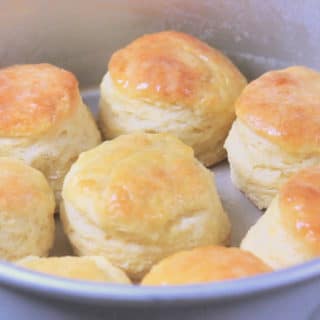
Yield: 8 Biscuits
Homemade Buttermilk Biscuits
Prep Time
20 minutes
Cook Time
15 minutes
Total Time
35 minutes
These homemade buttermilk biscuits are incredibly fluffy, tender, and flaky. You can make them with butter, lard, or shortening and the technique used will give you the best biscuits every time!
Ingredients
- 240 grams (2 cups) all-purpose flour
- 10 grams (1 tablespoon) baking powder
- ¼ teaspoon baking soda
- 6 grams (1 ¼ teaspoons) kosher salt
- 85 grams (6 tablespoons) unsalted butter, lard, or shortening, cold
- 240 grams (1 cup, 240 milliliters) buttermilk, cold, *see note for substitution
Instructions
PREP
- Line a sheet pan with parchment paper or a silicone baking mat.
- Measure out all ingredients. Keep the buttermilk and butter (or lard or shortening) cold in the refrigerator.
To Make the Biscuits:
- In a large mixing bowl, whisk together the flour (240 grams, 2 cups), baking powder (10 grams, 1 tablespoon), baking soda (¼ teaspoon), and salt (1 ¼ teaspoons).
- Add the cold butter, lard, or shortening (85 grams, 6 tablespoons) to the mixing bowl and cut it into the flour mixture. To do this, press down on the fat with the wires of the pastry blender or the tines of a fork as you move it around the bowl. Continue cutting the fat into the flour until most of the pieces of fat are about the size of peas with some pieces being about the size of a walnut half.
- Add the cold buttermilk (240 grams, 1 cup) into the bowl and stir with a spoon or a silicone spatula just until combined. This should only take a few turns. The dough will be pretty wet and sticky.
- Turn the dough out onto a lightly floured counter. Dust flour over the top of the dough. With floured hands bring the dough together into one mass.
- Pat the dough out (do not roll with a rolling pin) until it is about 1-inch (2.5 cm) thick. Using a bench knife (or a metal spatula can be helpful if you do not have a bench knife), fold the dough in half and then turn it 90 degrees. Pat out and fold again for a total of 6 times. This process is creating layers that will create flaky biscuits.
- Press the dough out to about 1-inch (2.5 cm) thick and use a round cutter that is about 2.5-inches (6 cm) in diameter to cut out your biscuits. When cutting out, dip your cutter in flour, press straight down, and pull it back up without twisting it. Twisting can seal the edge of your biscuit, not allowing it to rise fully. Gently pat the scraps together to cut out the rest of your biscuits. Alternatively, you can pat the dough into a rectangle and use a sharp knife to divide the dough into 8 rectangular-shaped biscuits.
- Place the biscuits on a parchment-lined baking sheet with the edges touching so they will rise up against each other.
- As an optional step, place the sheet pan in the freezer for 10 minutes before baking. This will ensure that your biscuits will not spread too much and will allow your oven to fully pre-heat.
- Bake at 450°F/230°C for 13-15 minutes until golden brown. Do not open the oven door for at least the first half of baking time. You want the steam to stay trapped in the oven to help with the rise.
- Brush biscuits with melted butter and sprinkle with flaky salt if desired.
- Biscuits are best eaten fresh, but they can also be stored after completely cooled at room temperature and wrapped in foil for 2 days. Alternatively, you can freeze the biscuits raw and bake straight from frozen at 425°F/220°C for 18-21 minutes, until baked through.
Notes
A note on buttermilk substitute: Buttermilk is acidic which adds a slightly tangy taste to these biscuits and also tenderizes and activates the baking soda, helping the biscuits to rise. If you do not have buttermilk on hand you can make a substitute using one of the options below.
- Sour Cream or Plain Yogurt: Combine 3/4 cup sour cream or plain yogurt with 1/4 cup water and use in place of the buttermilk. This is the best option for buttermilk substitute.
- Milk: Combine 1 TBSP lemon juice or white vinegar with enough milk to equal 1 cup. Let stand for 5 minutes before using. The higher the milk fat the better the substitute will be. 1% or skim milk is not ideal.